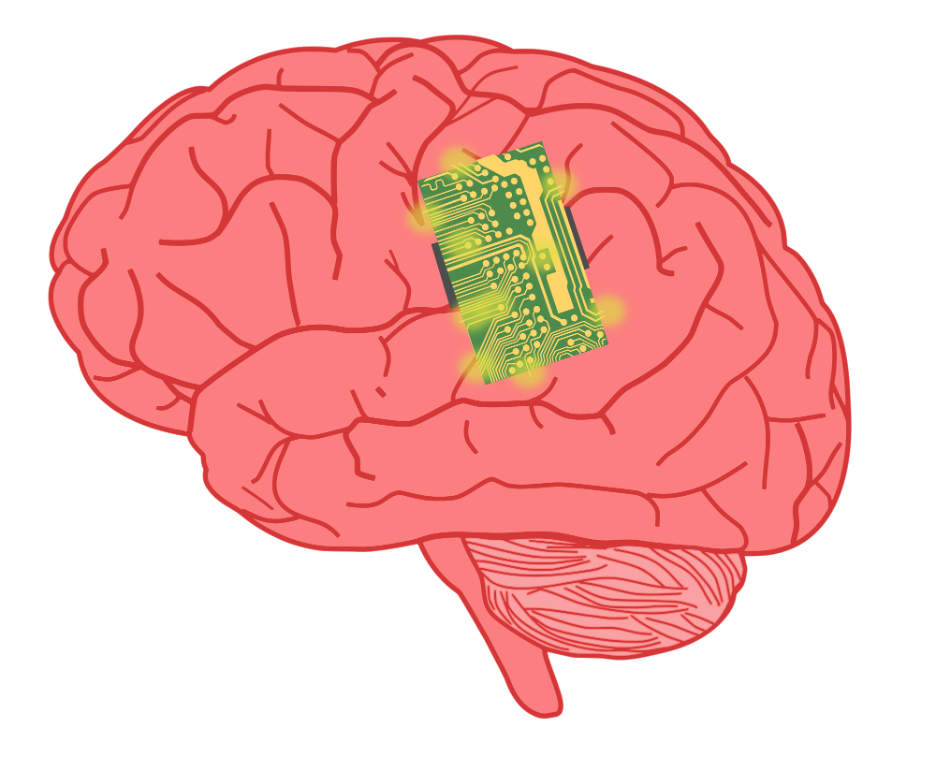For more related news, check out the UnknownNow, an organization for neuroscience research and service

Source: OpenClipArt, j4p4n
Introduction
Brain Computer Interfaces (BCIs) are communication systems that translate neural activity into commands for external devices. They function by capturing brain signals through various methods, such as electroencephalography (EEG) or implanted electrodes1. These signals are then processed and interpreted by a computer algorithm, allowing users to control machines or software applications directly with their thoughts1. The potential applications of BCI technology are vast and hold great promise for transforming communication and augmenting rehabilitation. For individuals with communication challenges due to paralysis or neurological conditions, BCIs could offer a new way to express themselves and interact with the world. BCIs could also play a crucial role in restoring lost motor function, allowing those with them to regain control over prosthetic limbs or assistive devices2.
Understanding Brain-Computer Interfaces
Brain Computer Interfaces (BCIs) began development in the 1930s3, but they have not undergone significant advancement until recently. Understanding the mechanisms behind BCIs is not as difficult as it may appear. In the first stage, BCIs capture electrical activity generated by the brain. A non-invasive approach for this capture is electroencephalography (EEG), which involves placing electrodes on the scalp to measure the brain’s electrical signals. Invasive BCIs use surgically implanted electrodes directly within the brain2. Although this invasive approach yields a more precise reading of the brain’s electrical activity, it requires a more complex procedure. In the second stage, BCIs decipher the brain’s language inside the electrical signals. Sophisticated algorithms analyze the raw brain signals, searching for specific patterns that correlate with our thoughts, intentions, or even motor commands. Finally, the BCI translates the decoded signals into real-time control commands for the desired external device4. These commands could involve anything from moving a cursor on a screen with your thoughts to operating a prosthetic limb. By interpreting brain activity and translating it into immediate actions, BCIs bridge the gap between our internal world of thoughts and the external world of devices. BCIs therefore pave the way for a more intuitive and natural way to interact with technology, offering immense potential for communication and rehabilitation.
Recent Developments in BCI Technology
One area of particular focus is the application of BCIs in mind-controlled prosthetics. Imagine amputees or those with limb disabilities regaining control and natural interaction with the world. Recent breakthroughs have shown impressive results, with users controlling prosthetic arms and even performing complex tasks, like playing sports5. This translates to a renewed sense of freedom and empowerment for the users, not just physically but also mentally. BCIs are also making waves in cognitive training through neurofeedback. This technique uses real-time brain activity feedback to train users to regulate their brainwaves and enhance specific cognitive functions. By wearing an EEG cap and focusing on keeping audio or visual feedback, users can train their brains for improved attention, and memory. This could be beneficial for people with ADHD or anxiety, or even athletes seeking to optimize their performance. Finally, for individuals with paralysis, BCIs offer a sense of hope for regaining mobility and independence. Researchers are actively exploring BCI use to control exoskeletons or other assistive devices. Studies have shown promising results, with patients regaining some control over paralyzed limbs through BCI-controlled exoskeletons6. Other areas of research focus on helping paralyzed individuals regain the ability to operate a powered wheelchair using a BCI. For example, consider the recent case study of a 38 year old male who sustained an incomplete cervical (C5/C6) spinal cord injury. He participated in the STIMO clinical trial (clinicaltrials.gov, NCT02936453), which involved a five-month neurorehabilitation program supported by targeted epidural electrical stimulation of the spinal cord. With the help of a front-wheel walker, the participant regained the ability to take steps7. These advancements pave the way for a future where BCIs can significantly improve the quality of life for people with paralysis.
Applications of BCI Technology in Healthcare and Rehabilitation
The recent technological developments of BCIs bring light to the various areas of applications for healthcare and rehabilitation, ranging from mind-controlled prosthetics to BCI-controlled exoskeletons. Researchers are actively integrating BCIs with exoskeletons and assistive devices, and early results are encouraging. BCIs can also be a lifeline for communication in individuals with amyotrophic lateral sclerosis (ALS), a disease that progressively weakens muscles. By offering alternative communication channels that bypass traditional speech, BCIs can empower ALS patients to maintain connection with loved ones and express themselves even as their physical capabilities decline8.
Beyond their capacity to overcome physical limitations, BCIs are making significant strides in cognitive rehabilitation and therapy. Techniques like neurofeedback, which utilizes BCIs to provide real-time feedback on brain activity, are showing promise in treating conditions like ADHD and anxiety disorders. By learning to regulate their brainwaves based on this feedback, individuals may be able to manage their symptoms more effectively9. Furthermore, researchers are exploring BC interventions in healthcare to improve memory and attention. This could involve stimulating specific brain regions, like the hippocampus, or providing targeted feedback through BCIs10.
Challenges and Future Directions
Although the recent developments in BCIs have underscored the potential of the technology in various fields, one of the most pressing concerns surrounding their use lies in the ethical considerations and potential privacy breaches. As BCIs delve deeper into the human brain, questions arise regarding user autonomy, and the security of sensitive brain data. Vulnerabilities can exist wherever there is a flow of sensitive information between computers, whether the data is transmitted via wires or wirelessly. Brain-computer interfaces (BCIs) are no exception to this rule and are therefore also exposed to the risk of being hacked, if adequate steps to ensure security are not taken10. Robust ethical frameworks and data privacy regulations will be essential to ensure responsible development and use of BCI technology11.
Despite recent advancements, current BCI technology faces limitations. Signal processing accuracy and long-term use comfort require further refinement. Additionally, more invasive BCI systems such as surgically implanted electrodes also have higher costs, which restricts accessibility for some users11. Continued research and development are needed to overcome these hurdles and make BCIs more affordable, user-friendly, and accessible to a wider population.
Brain-computer interfaces (BCIs) are emerging as a revolutionary technology with the potential to transform how we interact with the world. By capturing and translating brain activity into control signals, BCIs can bridge the gap between our thoughts and external devices. This exciting field holds immense promise for various applications, particularly in healthcare and rehabilitation. In particular, BCIs offer individuals with disabilities a novel, promising approach of restoring lost mobility and communication for those with paralysis or ALS. Beyond physical limitations, BCIs are making strides in cognitive rehabilitation, with neurofeedback techniques potentially improving conditions like ADHD. However, navigating the ethical considerations, privacy concerns, and technological limitations of BCIs is crucial. As research progresses towards more affordable, user-friendly, and advanced BCIs, the future holds exciting possibilities like brain-to-brain communication. Overall, BCI technology presents a transformative future where human-computer interaction is redefined, empowering individuals and revolutionizing healthcare and rehabilitation.
References
- McFarland, D. J., Sarnacki, W. A., & Wolpaw, J. R. (2010). Electroencephalographic (EEG) control of three-dimensional movement. Journal of Neural Engineering, 7(3), 036007. https://doi.org/10.1088/1741-2560/7/3/036007
- Mridha, M. F., Das, S. C., Kabir, M. M., Lima, A. A., Islam, Md. R., & Watanobe, Y. (2021). Brain-Computer Interface: Advancement and Challenges. Sensors, 21(17), 5746. https://doi.org/10.3390/s21175746
- Kawala-Sterniuk, A., Browarska, N., Al-Bakri, A., Pelc, M., Zygarlicki, J., Sidikova, M., Martinek, R., & Gorzelanczyk, E. J. (2021). Summary of over Fifty Years with Brain-Computer Interfaces—A Review. Brain Sciences, 11(1), 43. https://doi.org/10.3390/brainsci11010043
- Shih, J. J., Krusienski, D. J., & Wolpaw, J. R. (2012). Brain-Computer Interfaces in Medicine. Mayo Clinic Proceedings, 87(3), 268–279. https://doi.org/10.1016/j.mayocp.2011.12.008
- Magubane, N. (2023, June 28). Challenges and advances in brain-computer interfaces. Penn Today. https://penntoday.upenn.edu/news/challenges-and-advances-brain-computer-interfaces
- Colucci, A., Vermehren, M., Cavallo, A., Angerhöfer, C., Peekhaus, N., Zollo, L., Kim, W.-S., Paik, N.-J., & Soekadar, S. R. (2022). Brain–Computer Interface-Controlled Exoskeletons in Clinical Neurorehabilitation: Ready or Not? Neurorehabilitation and Neural Repair, 36(12), 747–756. https://doi.org/10.1177/15459683221138751
- 4. Lorach, H. et al. Walking naturally after spinal cord injury using a brain–spine interface. Nature 618, 1–8 (2023).
- Londral, A. (2022). Assistive Technologies for Communication Empower Patients With ALS to Generate and Self-Report Health Data. Frontiers in Neurology, 13. https://doi.org/10.3389/fneur.2022.867567
- Ordikhani-Seyedlar, M., Lebedev, M. A., Sorensen, H. B. D., & Puthusserypady, S. (2016). Neurofeedback Therapy for Enhancing Visual Attention: State-of-the-Art and Challenges. Frontiers in Neuroscience, 10. https://doi.org/10.3389/fnins.2016.00355.
- Engineering data security for brain-computer interfaces | Center for Neurotechnology. centerforneurotech.uw.eduhttps://centerforneurotech.uw.edu/engage-enable/post/engineering-data-security-brain-computer-interfaces.
- Carelli, L., Solca, F., Faini, A., Meriggi, P., Sangalli, D., Cipresso, P., Riva, G., Ticozzi, N., Ciammola, A., Silani, V., & Poletti, B. (2017). Brain-Computer Interface for Clinical Purposes: Cognitive Assessment and Rehabilitation. BioMed Research International, 2017, 1–11. https://doi.org/10.1155/2017/1695290
- Burwell, S., Sample, M., & Racine, E. (2017). Ethical aspects of brain computer interfaces: a scoping review. BMC Medical Ethics, 18(1). https://doi.org/10.1186/s12910-017-0220-y
- Karikari, E., & Koshechkin, К. А. (2023). Review on brain-computer interface technologies in healthcare. Biophysical Reviews, 15(5), 1351–1358. https://doi.org/10.1007/s12551-023-01138-6
Related Posts
Are We Addicted to Social Media?
Cover Image: In the current age, social media has become...
Read MoreProject Empathy: Addressing Substance Abuse in Low-Income Adolescents Across Baltimore
This publication is in proud partnership with Project UNITY’s Catalyst Academy 2024...
Read MoreA Novel Mental Health Literacy Education Program for Pre-Teens
Figure: A typical elementary school classroom in Japan (Cassidy, 2005). Source:...
Read MoreThe Public Health Humanitarian Crisis in Ukraine
This publication is in proud partnership with Project UNITY’s Catalyst Academy 2023...
Read MoreHow the Bystander Effect on Security Robots can Hamper Law Enforcement
BigDog robots being tested under the supervision of a Boston...
Read MoreBeyond the White Coat Worker: An Overview of Citizen Science
By: Olivia Brado1, Luz Mariana Cumpa Gomez1, Shirin Dadina1, Katrina...
Read MoreAamuktha Yalamanchili






